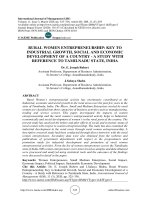Economic growth and economic development 29
Bạn đang xem bản rút gọn của tài liệu. Xem và tải ngay bản đầy đủ của tài liệu tại đây (49.07 KB, 1 trang )
12
Introduction to Modern Economic Growth
LUX
11
IRL
USA
NOR NLD
ITA BEL
CAN
AUS
AUT
FINFRA DNK
SWE CHE
ISL
GBR
ESP ISR
NZL
JPN
KOR
GRC
PRT
BRB
MUS
MYS
TTO
ARG
CHLMEX
SYC
ZAF
URY
BRA IRN
VEN
GAB
DOMPAN JOR
SYR
TUR
CRI
EGY
GTM SLV
MAR ECU COL
PRY
PER
PHL
JAM
BOL
HND
GIN
NIC
log gdp per worker 2000
8
9
10
HKG
THA
ROM IDN
PAK
IND
CHN
CPV
LKA
BGD
ZWE
CIV
COG
LSO NPL
MWI
7
GNB
BFA
UGA
ETH
CMR
COM
SEN
GHA
GMB
ZMB
TCD
BEN
KEN
TGO MOZ
MLI
MDG
NER
RWA
NGA
TZA BDI
6
7
8
9
log gdp per worker 1960
10
Figure 1.9. Log GDP per worker in 2000 versus log GDP per worker
in 1960, together with the 45◦ line.
observations for all countries going back to 1820. Finally, while these data do
include a correction for PPP, this is less reliable than the price comparisons used
to construct the price indices in the Penn World tables. Nevertheless, these are the
best available estimates for differences in prosperity across a large number of nations
going back to the 19th century.
Figures 1.10 shows the estimates of the distribution of countries by GDP per
capita in 1820, 1913 (right before World War I) and 2000. To facilitate comparison,
the same set of countries are used to construct the distribution of income in each
date. The distribution of income per capita in 1820 is relatively equal, with a very
small left tail and a somewhat larger but still small right tail. In contrast, by 1913,
there is considerably more weight in the tails of the distribution. By 2000, there are
much larger differences.
15









